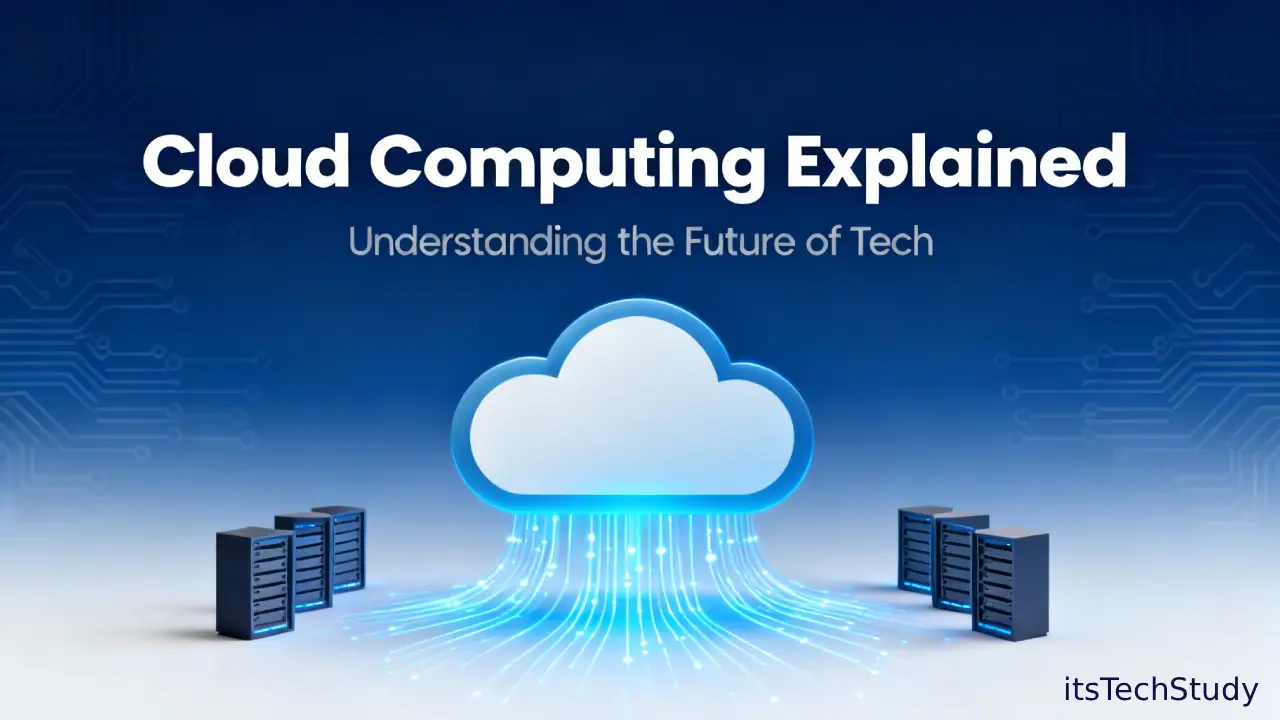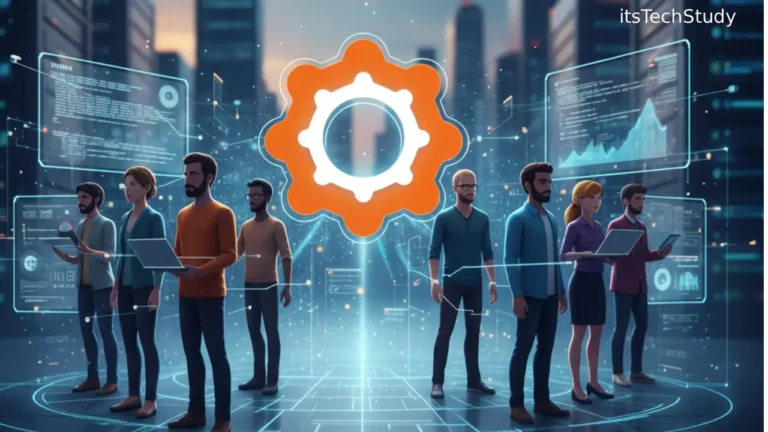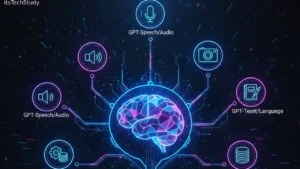Introduction: The Cloud Revolution and Its Increasing Significance
A Decade ago, it was not imaginable to store voluminous data, execute complicated applications, or host enterprise systems without having on-premise servers. Jump to 2025, and the cloud computing technology is the pillar of digital transformation.
From startups to multinationals, companies are adopting cloud platforms to save on costs, enhance scalability, and foster innovation. Nevertheless, even with its acceleerated growth rate, it is still puzzling to many why it is essential to business today and how the cloud functions, as well as which new technology trends in 2025 are defining this phenomenon.
In this article, we’ll explore how cloud computing is transforming digital innovation, its key benefits and challenges, the major service models, and what the future holds for this game-changing technology.
What Is Cloud Computing Technology?
At its core, cloud computing refers to delivering computing services-such as servers, storage, databases, networking, software, and analytics-over the internet (“the cloud”).
Rather than keeping physical data centers or equipment, users obtain resources on an on-demand basis from cloud providers such as Amazon Web Services (AWS), Microsoft Azure, azure and Google Cloud Platform (GCP).
This transformation from legacy infrastructure to cloud-based infrastructure has upended how companies create, deploy, and operate their digital solutions.
How Cloud Computing Drives Digital Innovation
The relationship between cloud computing technology and digital innovation is undeniable. Cloud is a bedrock for AI innovation, IoT integration, data analytics, and automation-all key drivers of the future of technology.
Here’s why:
- Faster Development Cycles: Cloud platforms facilitate agile development and continuous integration, shortening time to market for new applications.
- Global Scalability: Businesses can quickly add resources during peak demand and remove them when not required.
- Cost Optimization: Pay-as-you-go provisions avoid the investment in heavy hardware.
- Improved Collaboration: Groups worldwide share spaces in real time.
- Data-Driven Decisions: Cloud analytics software makes big data actionable with insights.
Key Models of Cloud Computing
Cloud computing is based on three primary service models, which serve different business requirements:
| Model | Full Form | Description | Example Providers |
|---|
| IaaS | Infrastructure as a Service | Provides virtualized computing resources such as servers and storage. | AWS EC2, Google Compute Engine |
| PaaS | Platform as a Service | Offers development platforms and tools for app creation without managing infrastructure. | Microsoft Azure, Heroku |
| SaaS | Software as a Service | Delivers ready-to-use software applications via the internet. | Google Workspace, Salesforce |
Deployment Models of Cloud Computing

Depending on organizational requirements, cloud computing can be deployed in various ways:
- Public Cloud – Managed by third-party providers; cost-effective and easily scalable.
- Private Cloud – Exclusive infrastructure for a single organization; provides greater control and security.
- Hybrid Cloud – Wherein both public and private configurations are combined to ensure flexibility and cost-optimized workloads.
- Multi-Cloud – Implements several cloud providers to prevent vendor lock-in and improve reliability.
Benefits of Cloud Computing Technology
Let us see the primary benefits that make cloud computing an unavoidable part of contemporary technology infrastructure.
Pros
- Scalability: Resources can be scaled up or down according to needs.
- Cost-Efficiency: Minimizes the use of hardware and maintenance needs.
- Accessibility: Allows access to applications and information from anywhere.
- Business Continuity: Provides disaster recovery and downtime losses are low.
- Environmental Sustainability: Saves energy with sharing of resources.
- Faster Innovation: Facilitates innovation with advanced applications such as AI and machine learning.
Cons
- Data Security Concerns: Sensitive information kept in third-party servers may be at risk.
- Downtime Risks: Service provider outages can affect the business.
- Compliance Challenges: Countries have different data regulations.
- Limited Control: The infrastructure is handled by the provider, rather than the user.
New Trends in Cloud Computing for 2025
Recent technology trends in 2025 reveal how cloud computing is rapidly developing further. Let’s see the most prominent innovations that are shaping this industry.
- Integration of Edge Computing
Following the boom of IoT devices, bringing data processing closer to the origin minimizes latency and enhances performance. Edge and cloud now go hand-in-hand for real-time analysis.
- AI-Driven Cloud Services
AI innovations are turning the cloud intelligent. Platforms now do automatic resource management, enhance security, and maximize workloads.
- Multi-Cloud and Hybrid Ecosystems
Companies more and more employ multi-cloud strategies to benefit from varying vendor strengths, steer clear of reliance, and build in resilience.
- Quantum Computing on Cloud
Tech titans are testing quantum computing as a service (QCaaS) to introduce unparalleled computational capacity to sectors such as the pharmaceutical, financial, and cybersecurity industries.
- Sustainable Cloud Infrastructure
Green technology and carbon-neutral data centers are also emerging as a central focus, bringing cloud expansion in sync with greener responsibility.
Cloud Computing vs Conventional IT Infrastructure
Here’s a brief comparison that summarizes why businesses are shifting so fast to the cloud:
| Feature | Traditional IT | Cloud Computing |
|---|---|---|
| Setup Cost | High initial investment | Pay-as-you-go pricing |
| Maintenance | Requires in-house IT staff | Managed by provider |
| Scalability | Limited and slow | Instant and flexible |
| Accessibility | On-premise only | Global, anytime access |
| Innovation Speed | Slow deployment | Rapid and agile |
| Disaster Recovery | Complex and costly | Built-in and automated |
The Role of Cloud Computing in Business Transformation
Cloud computing is not merely about technology—it’s about transformation of strategy. Here’s how organizations are using it:
- Startups: Launch scale-up apps without huge capital outlays.
- Enterprises: Streamline operations and embed AI-powered analytics.
- Healthcare: Securely manage patient data and facilitate telemedicine.
- Education: Provide online education via SaaS platforms.
- E-commerce: Easily manage seasonally induced demand spikes.
By 2025, more than 85% of companies are expected to have cloud-first approaches, highlighting how paramount this technology has become for competitiveness.
Cloud Security Challenges and Best Practices
Although cloud computing has several benefits, cybersecurity is the most critical issue. As more information goes online, protection becomes essential.
Common Cloud Security Risks
- Data breach
- Illicit access
- Misconfigured storage
- Insecure APIs
Cloud Security Best Practices
- Implement Multi-Factor Authentication (MFA) to protect logins.
- Encrypt sensitive information in transit as well as at rest.
- Keep permissions up-to-date and watch for suspicious activity.
- Select compliant providers that adhere to ISO, GDPR, and HIPAA standards.
- Use Zero Trust Architecture to reduce internal threats.
How Cloud Computing Enables Emerging Technologies
Cloud computing is the foundation for emerging tech environments. Let’s examine how it complements major innovations:
- Artificial Intelligence (AI): Cloud environments host AI software and models, making sophisticated analytics available.
- Internet of Things (IoT): Cloud provides the master hub for IoT sensor data gathered from billions of sensors.
- Blockchain: Cloud-based blockchain systems make deployment and scalability easier.
- 5G Networks: Integrate with cloud for super-fast, low-latency connectivity driving smart cities and autonomous systems.
Future of Cloud Computing Technology
Cloud computing will be the cornerstone of technology in the future. In 2030, we will witness:
- Autonomous Cloud Management driven by AI and machine learning
- Serverless Architecture being adopted broadly, minimizing operational overhead.
- More Personalization in cloud services specifically for individual industries.
- Increased Emphasis on Security and Compliance as data sovereignty legislation develops.
As technological innovations escalate, cloud computing will continue to be the stage on which digital ecosystems flourish—powering everything from AI advancements to international sustainability projects.
Conclusion: Cloud Computing — The Heart of Tomorrow’s Innovation
Cloud computing technology isn’t simply another technology trend—it’s the backbone of today’s digital transformation. From driving artificial intelligence and big data to supporting remote work and intelligent devices, it continues to define how we live and work.
As we progress further into 2025 and beyond, cloud computing will only become smarter, more sustainable, and more accessible. Companies that take up this change now will be the champions of tomorrow’s digital economy.
FAQs About Cloud Computing Technology
Q1: What are the main types of cloud computing services?
Ans: The three primary types are IaaS (Infrastructure as a Service), PaaS (Platform as a Service), and SaaS (Software as a Service). Each offers different levels of control and flexibility.
Q2: Is cloud computing secure for businesses?
Ans: Yes—when configured properly and paired with encryption, multi-factor authentication, and compliance frameworks, cloud systems can be highly secure.
Q3: How does cloud computing save costs?
Ans: Cloud services eliminate hardware expenses, reduce IT maintenance costs, and allow businesses to pay only for what they use.
Q4: Can small businesses benefit from the cloud?
Ans: Absolutely. Cloud platforms help startups and small firms scale quickly without large infrastructure investments.
Q5: What are the disadvantages of cloud computing?
Ans: Potential downsides include data privacy concerns, internet dependency, and compliance challenges with regional regulations.
Q6: What is the future of cloud computing technology?
Ans: Expect more automation, hybrid solutions, AI integration, and green computing initiatives as cloud technology continues to mature.












No Comments Yet
Be the first to share your thoughts.
Leave a Comment